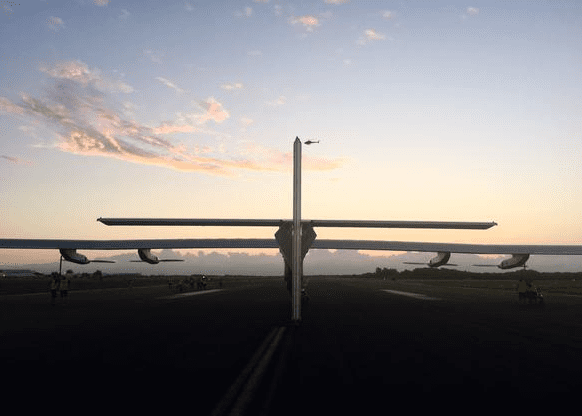The world’s longest solar-powered flight came to a triumphant end on Friday when the Solar Impulse 2 landed safely in Hawaii after flying a record-breaking 7,200km across the Pacific from Japan – a nearly 118-hour, non-stop journey powered only by the sun.

“This is the flying proof that the #futureisclean!,” said the Solar Impulse RTW website on Friday. “We have just made it from Nagoya to Hawaii in 117 hours and 52 minutes, to demonstrate the potential of existing clean technologies. We can fly day and night in an airplane without fuel!”
In a statement on Friday, the Solar Impulse team said the the successful completion of the round-the-world trip’s 8th leg, after being airborne for five consecutive days and nights, had proven that the airplane’s critical components performed exceptionally and that their vision of reaching unlimited endurance without fuel, using solely the power of the sun, was a reality.
Swiss pilot André Borschberg, whose legs had to be massaged back to life after five days straight sitting in the solar plane’s cockpit, said he felt “exhilarated” after manning the longest and most challenging leg of the round-the-world trip, which also set an absolute record for a solo un-refuelled journey.
“I have climbed the equivalent altitude of Mount Everest five times without much rest… This success fully validates the vision that my partner Bertrand Piccard had after his round-the-world balloon flight to reach unlimited endurance in an airplane without fuel,” Borschberg said.
The awe-inspiring plane is fitted with 17,248 SunPower monocrystalline solar cells across its 72-meter wingspan, tailplane and fuselage, and stores excess solar energy in four lithium ion batteries attached two to a wing.
As noted here last week, this technology is truly pushing the frontiers, as the plane’s ground crew, in Monaco, manages the crucial balance between generation from the solar panels and the charge from the batteries.
“Each morning, the team anxiously awaits the turning point of ‘energy neutral positive’, a cumbersome expression to mark the point where the solar panels produce enough to charge batteries as well as fly the plane.”
HE MADE IT! @andreborschberg just touched down in #Hawaii after a record-breaking flight! #futureisclean@b… https://t.co/WQWsRKiCEi
— SOLAR IMPULSE (@solarimpulse) July 3, 2015
“What André has achieved is extraordinary from the perspective of a pilot. But furthermore, he has also led the technical team during the construction of this revolutionary prototype,” Piccard said after Borschberg touched down at Hawaii’s Kalaeloa Airport.
“This oceanic flight to Hawaii demonstrates that if technological solutions exist to fly a plane day and night without fuel, then there is potential for these same efficient technologies to be used in our daily lives, and to achieve energy savings to reduce CO2 emissions.
After two months waiting for this flight to Hawaii, we finally proved it was possible! pic.twitter.com/d0lbeUGPfB
— Bertrand PICCARD (@bertrandpiccard) July 3, 2015
Piccard also used the occasion to remind supporters of another of solar flight’s main goals: to help convince governments around the globe to implement the necessary cleantech solutions and help ensure that the upcoming UN climate conference was successful in renewing the Kyoto protocol this December in Paris.
Bertrand Piccard will fly to Phoenix for the next leg of the Round-The-World attempt – a leg that, while not as far as that just completed, will still likely take four days and nights.
From Phoenix, Solar Impulse will head for New York and an Atlantic crossing that will eventually see it return to Abu Dhabi, where the adventure first started.
First, however, the ground crew in Kalaeloa will take a few days to check over the aircraft, while meteorologists look for a suitable flight window.







